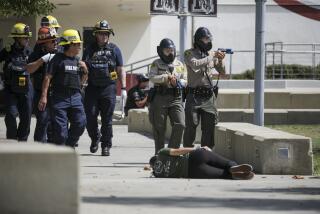Bus Safety : Making the Ride to School Safer
For many children, going back to school means riding a bus. State and federal transportation officials say that school buses are one of the safest forms of transportation. They were involved in fewer than 0.4% of the 430,000 fatal traffic crashes nationwide since 1983. Yet injuries to school-age children do occur and, with many students returning to class, bus safety remains a concern.
National School Bus Safety Week is Oct. 15-21, and local school districts and groups are doing their part to heighten the awareness of parents, students and drivers.
Safety Measures
The federal government sets standards for vehicles manufactured in the U.S. Some states require more. In California, school buses must have a minimum of two emergency exits in addition to the entry door. Regulations requiring such things as safer seating and increased roof strength first went into effect in 1977. Since then, new state regulations have been issued requiring:
* Upgraded braking system
* Pop-out stop signs added to sides of buses.
* Two amber lights added to the existing red ones on top of bus, for total of eight lights.
* Handrails: Since 1991, five students nationwide have been killed and others injured when their clothing or book bags became tangled in handrails as they exited the bus. No new regulations have been adopted, but some companies are retrofitting buses to fix the rails.
Tips for Riders
A local organization called Safe Moves educates children about traffic safety. Here are their tips for school bus riders:
* Arrive at bus stop at least five minutes before bus arrives.
* Stay out of street and don’t play around bus stop.
* Always wait for parents on the same side of street as school bus loading zone.
* Cross at least 10 feet in front of bus so you can see the driver.
* Children should also be made aware of the bus driver’s blind spot, which occurs in an area 10 feet in front of the driver. In this zone, the driver cannot see a child. This is doubly dangerous because the child is passing in front of the bus and into traffic, where he cannot be seen by other vehicles.
Safety Inspections
School buses in Los Angeles are inspected every 13 months by the CHP. If a bus passes, it receives a certificate. If a bus doesn’t pass, it may stay in service, but no certificate is issued until the repairs are completed. Buses with serious violations are taken out of service.
Los Angeles inspections, 1994
* Total: 6,592 buses
* Passed inspection: 4,703
* Not certified: 1,339
* Taken out of service: 550
Bus Statistics, Statewide
Total school buses
1993: 22,633
1994: 22,881
Total mileage traveled
1993: 288,537,478
1994: 310,405,620
(increase of 7.57%)
Accidents and Injuries
Although there were more accidents involving buses and injury collisions in 1994 . . .
Total Accidents involving buses:
1993: 2,174
1994: 2,209
Injury collisions:
1993: 495
1994: 505
(increase of 2%)
. . . there were fewer pupil passenger injuries:
Pupil passenger injuries:
1993: 745
1994: 700
Citywide School Bus Collisions
There have been 235 fewer accidents reported in the first six months of this year, compared to the same time last year--a 46% decrease. The number of accidents has been decreasing since 1991, when CHP implemented its own driver testing program.
(Year: Number of Accidents)
1991: 840
1992: 702
1993: 706
1994: 705
When the Driver is at Fault
Although there have been no passenger fatalities in the past two years, there were six collisions resulting in non-passenger fatalities in 1994, double the number in 1993.
Percent of Collisions where the Driver Was at Fault:
1993: 41%
1994: 39%
Top Three Causes of Driver-Caused Accidents:
* Improper turning
* Unsafe speed
* Unsafe starting and backing up
Sources: California Highway Patrol; Laidlaw Transit, Inc.; National Highway Traffic Safety Administration; Safe Moves.
Researched by JULIE SHEER / Los Angeles Times
More to Read
Sign up for Essential California
The most important California stories and recommendations in your inbox every morning.
You may occasionally receive promotional content from the Los Angeles Times.










